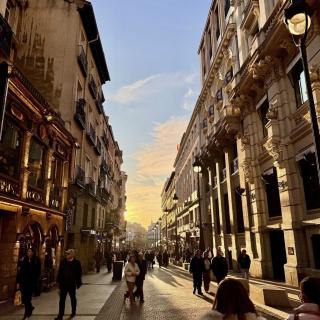When you go abroad, whether you’re studying abroad or just traveling for fun, the world becomes your classroom. Your time will likely be shaped by everything you want to see: imagine island hopping in the Galápagos Islands and exploring the breathtaking architectural works of Antoni Gaudí in Barcelona. These activities are UNESCO World Heritage Sites – let’s find out a little more about what that means.
What is a UNESCO World Heritage Site?
A UNESCO World Heritage Site is defined as a landmark or area selected by the United Nations Educational, Scientific and Cultural Organization (UNESCO) as having cultural, historical, scientific or other form of significance. In addition to having the UNESCO World Heritage Site designation, these Sites are legally protected by international treaties.
A World Heritage Site can be a marvelous work of architecture (e.g. Machu Picchu) a beautiful natural treasure (e.g. the Great Barrier Reef) or even a city center (more on that later). Each site must possess “outstanding universal value” to be considered a World Heritage Site by UNESCO, meaning they must not only be important to the people and the country that they’re in but to people around the world as well.
The way we like to think about World Heritage Sites here at IES Abroad is that they are both treasures and pieces of evidence.
UNESCO World Heritage Sites Near IES Abroad Centers
Our IES Abroad Centers are near more than 30 UNESCO World Heritage Sites. We’ve compiled a list of six of these amazing world treasures for you to learn about and enjoy:
1. Amsterdam, Netherlands – Seventeenth-Century Canal Ring

When visiting Amsterdam, it’s almost obligatory to take a photo in front of one of its world-famous canals. The canals are much more than a prop for a cool selfie, or a way to get from here to there, though. Built in the 17th century, they’re the result of incredible city planning. At the time of their construction, the canals were highly-advanced pieces of engineering and provided the world with a model of urban expansion.
What UNESCO says: “The Amsterdam Canal District illustrates exemplary hydraulic and urban planning on a large scale through the entirely artificial creation of a large-scale port city… in the 17th and 18th centuries, Amsterdam was seen as the realization of the ideal city that was used as a reference urban model for numerous projects for new cities around the world.”
2. The Galápagos Islands, Ecuador

It’s no surprise that The Galápagos Islands were one of the first UNESCO World Heritage Sites. These 19 islands are home to some of the most unique animals, flora, and fauna on the planet, and, up until 2012, the last known Pinta Island tortoise to ever exist. The islands’ special bio-diversity coupled with their impeccable natural beauty have captivated travelers and scientists – like the great Charles Darwin – for generations.
What UNESCO says: “This archipelago and its immense marine reserve is known as the unique ‘living museum and showcase of evolution’. Its geographical location at the confluence of three ocean currents makes it one of the richest marine ecosystems in the world.
3. Barcelona, Spain - Sagrada Familia (the Works of Antoni Gaudí)

Whether you recognize his name or not, Antoni Gaudí’s distinct architectural designs are sure to be familiar as soon as you see them. La Pedrera, Casa Vicens, Palau Güell – these are just some of the breathtaking designs that Gaudí has created. But perhaps his most famous work (arguably, of course), the Sagrada Familia, is a testament to his incredible talent and intellect. The church’s design is so intricate that it has been under construction for more than 130 years and isn’t even scheduled to be finished until 2026. Not surprisingly, it’s the longest running architectural project in history.
What UNESCO Says: “The Works of Antoni Gaudí is an exceptional and outstanding creative contribution to the architectural heritage of modern times.”
4. Paris, France – The Palace of Versailles

Though technically not in Paris, The Palace of Versailles is only a short train ride from the city. Its captivating history and regal beauty earned it a spot on UNESCO’s prestigious World Heritage List in 1979 and draws over 3 million travelers a year.
Originally a small hunting lodge used for his father’s weekend getaways, King Louis XIV transformed the small lodge into the quintessential, royal palace. Louis XIV spent years pouring time, energy, and money into the palace, making it the opulent masterpiece that it is today. The Palace of Versailles now covers more than 700,000 square feet and has over 2,300 elegantly adorned rooms, each a nod to France’s Grand Siècle or Great Century.
What UNESCO Says: “Embellished by several generations of architects, sculptors, decorators and landscape architects, it provided Europe with a model of the ideal royal residence for over a century.”
5. Quito, Ecuador – City of Quito

Although the entire city has been named a UNESCO World Heritage Site, Quito’s city center is one of the many gems that earned its name on the list. Built upon the ruins of an ancient Incan city, the city center is the “least altered historic center in Latin America,” according to UNESCO.
Its nearly perfect preservation has not been by accident and lack of effort. Modern construction in Quito typically happens outside of the historic center to ensure the protection of the center’s historic architecture. The city center is filled with remnants of both Ecuador’s pre-Colombian, indigenous past, as well as its time throughout Spanish colonization. Now both indigenous and European influences are visible when walking through its city streets—ones that were designed more than 250 years ago.
What UNESCO says: “The city of Quito forms a harmonious ensemble where nature and man are brought together to create a unique and transcendental work.”
6. Sydney, Australia – Sydney Opera House

The Sydney Opera House is one of the most recognizable pieces of architecture in the world. The iconic design was created by architect Jorn Utzon and was initially rejected during the 1956 competition to design the opera house. His first sketches were pulled out of the rejection pile by American juror Eero Saarinen and Utzon would go on to win the competition. Though he reportedly never got the chance to see his work completed, Utzon gave Sydney and the rest of the world a remarkable piece of architecture, design, and engineering.
What UNESCO says: “The Sydney Opera House constitutes a masterpiece of 20th-century architecture. Its significance is based on its unparalleled design and construction; its exceptional engineering achievements and technological innovation and its position as a world-famous icon of architecture."
Interested in learning more about these and IES Abroad’s 140+ programs across the globe? Try our Program Finder to search by location, area of study, interest, and more!





